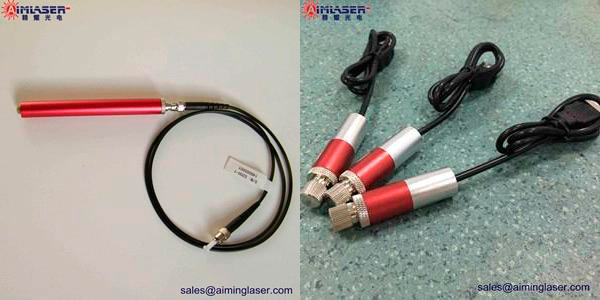Laser designator, also known as laser pointer, star pointer, etc., is the visible laser designed to be portable, easy to hold, laser module (light emitting diode) processed into a pen transmitter. Common laser designators are red light (λ= 650-660nm, 635nm), Green light (λ=515-520nm, 532nm), blue light (λ= 445-450nm) and blue violet light 405nm. It is usually used in presentations, teaching, and tour guides to project a spot of light or a ray of light to an object, but it is not suitable for use in certain places, such as art galleries (some paintings are afraid of light), zoos, etc.

In the US, lasers are classified by the American National Standards Institute and the FOOD and Drug Administration (FDA). Visible light laser Pointers with power less than 1mW (wavelength 400-700nm) belong to the second Class (Class 2 or II). Power between 1 and 5mW is Class 3A (Class 3A or IIIa). The third Class B (Class 3B/IIIb) laser (power 5-500MW) and the fourth Class (Class 4/IV) laser (power > 500mW) according to the law cannot be promoted and sold in the name of laser pen.
Most laser Pointers are red, green and blue are rare and expensive. Red laser Pointers, which first appeared in the 1980s, were bulky, bulky devices costing hundreds of dollars; It's small and it's cheap. The red laser pointer is easier to make, because there is a laser diode that generates this wavelength, so its structure is the simplest, basically just a diode powered by a battery. Wavelength is about 600 nanometers, there are mature technology, there are mature semiconductor process materials. In recent years, diode pumped solid state laser (DPSS) red laser pointer with wavelength of 671nm has appeared. Although this wavelength can be obtained using cheap diodes, DPSS technology can produce higher-quality, narrower lasers.
At present, the current GB7247 standard in China divides the risk of laser to human body into four levels, and the measurement standard is to observe the LASER on the eye MPE (maximum possible impact) in the beam. Standard level 1 lasers have a power output of less than 0.4 milliwatts, because they do no damage to the eyes or skin under any conditions, or even to the human body when focused through an optical system, so they do not need to be specifically regulated.
Many laser Pointers and flashlights sold in the market are grade IIIB, with power exceeding 5mW. Direct laser into the eyes may cause damage to the eyes. Some high power laser Pointers, diffuse light may also cause eye damage, after focusing more likely to ignite combustible items. So laser Pointers are not toys, not suitable for children.Special safety glasses should be worn when handling high-power lasers, especially those that cannot be seen. Also, no matter how powerful the laser must be avoided.
To avoid shooting yourself and others in the eye, the laser itself should also carry a warning label. High power laser pointer, can point firecrackers, burning balloons, lighting cigarettes. Laser Pointers are selling like hot cakes on shopping websites as a toy. Some stores advertise, with video evidence, that laser Pointers, which require only a few button batteries, can light cigarettes and firecrackers from a distance. When the laser pointer's beam accidentally slides across the surface of human skin, it causes a burning sensation. Therefore, when using the laser pointer, do not let the laser beam directly into the eye. Because this kind of injury is irreversible, especially this kind of high-power laser pen, can not give children to play, to avoid unnecessary injury.